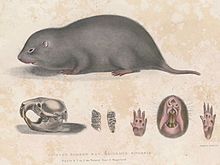Chinese bamboo rat
| Chinese bamboo rat | ||||||||||||
|---|---|---|---|---|---|---|---|---|---|---|---|---|

Chinese bamboo rat ( Rhizomys sinensis , stuffed specimen) |
||||||||||||
| Systematics | ||||||||||||
|
||||||||||||
| Scientific name | ||||||||||||
| Rhizomys sinensis | ||||||||||||
| Gray , 1831 |
The Chinese bamboo rat ( Rhizomys sinensis ), also Chinese root rat , is a rodent species from the genus of the bamboo rats ( Rhizomys ). It occurs in East Asia from the southeast of the People's Republic of China to the north of Myanmar and Vietnam .
features
The Chinese bamboo rat reaches a head-trunk length of 21.6 to 38.0 centimeters with a tail of 5.0 to 9.6 centimeters in length and a weight of about 1875 to 1950 grams. The rear foot length is 38 to 46 millimeters, the ear length 15 to 19 millimeters. The very soft fur on the back and the sides of the body are brownish gray, the forehead and the sides of the head are a little darker. The ventral side is sparsely hairy.
| 1 | · | 0 | · | 0 | · | 3 | = 16 |
The skull reaches a length of 58 to 87 millimeters. The occiput is clearly pronounced and curved, it is very high. The forehead crest (sagittal crest) is flat compared to the other species of the genus. The skull is also less wide than that of the gray bamboo rat ( Rhizomys pruinosus ) and the zygomatic arches are narrower. The animals have like other Spalacidae maxillary per half an an incisor tooth trained incisors (incisive) to which a tooth gap ( diastema follows). This is followed by three molars , premolars missing. In total, they have a set of 16 teeth. The upper incisors are almost perpendicular to the maxillary bone and are not protruding.
distribution
The Chinese bamboo rat occurs in East Asia from the southeast of the People's Republic of China to the north of Myanmar and Vietnam . Occurrences in Laos are suspected. The altitude distribution is around 1200 to 4000 meters.
Way of life
The Chinese bamboo rat lives mainly in bamboo forests and less often in the pine forests of high altitudes. In areas where it is sympatric with the gray bamboo rat ( Rhizomys pruinosus ), the Chinese bamboo rat usually occurs at altitudes above 1000 meters, while the gray bamboo rat lives in the lower areas.
The animals live solitary in burrows that they dig in soft ground. The burrows have several, about four to six, locked entrances, which are identified and recognizable by heaps of earth. The heaps of earth have a diameter of 50 to 80 centimeters and are 20 to 40 centimeters high. The corridors are up to 45 meters long and are about 20 to 30 centimeters deep in the ground. The nest is a chamber with a diameter of 20 to 25 centimeters, it is lined with bamboo leaves. Each building also has at least one escape tunnel. The burrow is inhabited for about a year, after which the animals look for a new area for the next burrow due to the decreasing sources of food. They feed mainly on bamboo roots and sprouts, which they usually look for above ground.
Reproduction takes place throughout the year, with a particularly large number of offspring in spring. During the mating season, the males come to mate in the females' burrows. The litters usually consist of two to four young animals that are born as nestlings . Weaning from breast milk takes place around three months after the birth.
In addition to humans, the predators of the species include both the little panda ( Ailurus fulgens ) and the snow leopard ( Panthera uncia ).
Systematics

The Chinese bamboo rat is classified as an independent species within the genus of bamboo rats ( Rhizomys ), which consists of three species. The first scientific description comes from John Edward Gray from 1831, who described the species on the basis of individuals from the area around Guangzhou in the Guangdong Province in China. It is possible that this is not a single species, but a species complex with several closely related species.
Status, threat and protection
The Chinese bamboo rat is classified as Least Concern by the International Union for Conservation of Nature and Natural Resources (IUCN). This is justified with the very large distribution area and the assumed large populations of the species. If there are actually several species, a reassessment is necessary. In parts of the distribution area the species is heavily hunted and used as a source of meat.
supporting documents
- ↑ a b c d e f g h i Andrew T. Smith: Chinese Bamboo Rat. In: Andrew T. Smith , Yan Xie: A Guide to the Mammals of China. Princeton University Press, Princeton NJ 2008, ISBN 978-0-691-09984-2 , pp. 213-214.
- ↑ Andrew T. Smith: Family Spalacidae. In: Andrew T. Smith , Yan Xie: A Guide to the Mammals of China. Princeton University Press, Princeton NJ 2008, ISBN 978-0-691-09984-2 , p. 209.
- ↑ a b c d e f Rhizomys sinensis in the IUCN Red List of Threatened Species 2015.4. Posted by: D. Lunde, K. Aplin, G. Musser, 2008. Retrieved July 21, 2016.
- ↑ Rhizomys sinensis . In: Don E. Wilson , DeeAnn M. Reeder (Eds.): Mammal Species of the World. A taxonomic and geographic Reference. 2 volumes. 3. Edition. Johns Hopkins University Press, Baltimore MD 2005, ISBN 0-8018-8221-4 .
literature
- Andrew T. Smith: Chinese Bamboo Council. In: Andrew T. Smith , Yan Xie: A Guide to the Mammals of China. Princeton University Press, Princeton NJ 2008, ISBN 978-0-691-09984-2 , pp. 213-214.
Web links
- Rhizomys sinensis inthe IUCN Red List of Threatened Species 2015.4. Posted by: D. Lunde, K. Aplin, G. Musser, 2008. Retrieved July 21, 2016.